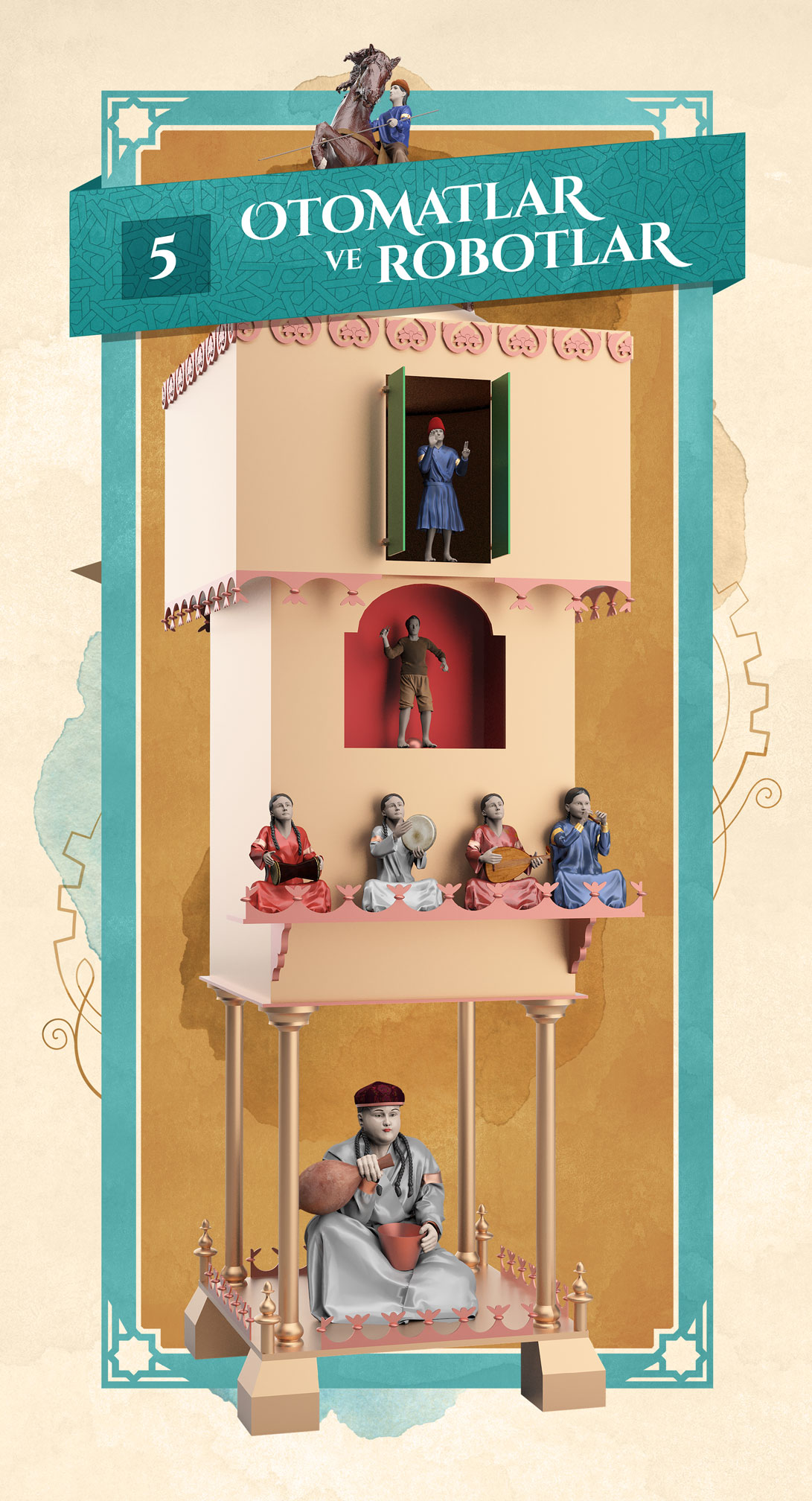Machines that act like they have souls
In his own book, Jazari likens the movements of machines to spirituality. In another word, the machines act like they have souls. It seems that the idea of dressing up the machines with human statues, or in another word, combining humanlike features with machines, began as a sense of humor at first. After all, instead of a drinks serving page, an automat that looks like a drink serving page might have been fun. However, Jazari’si humanlike automata can be seen as the first roots of the idea of modern Android robots of our time.
The Bath Servant Boy Automat Reconstructed
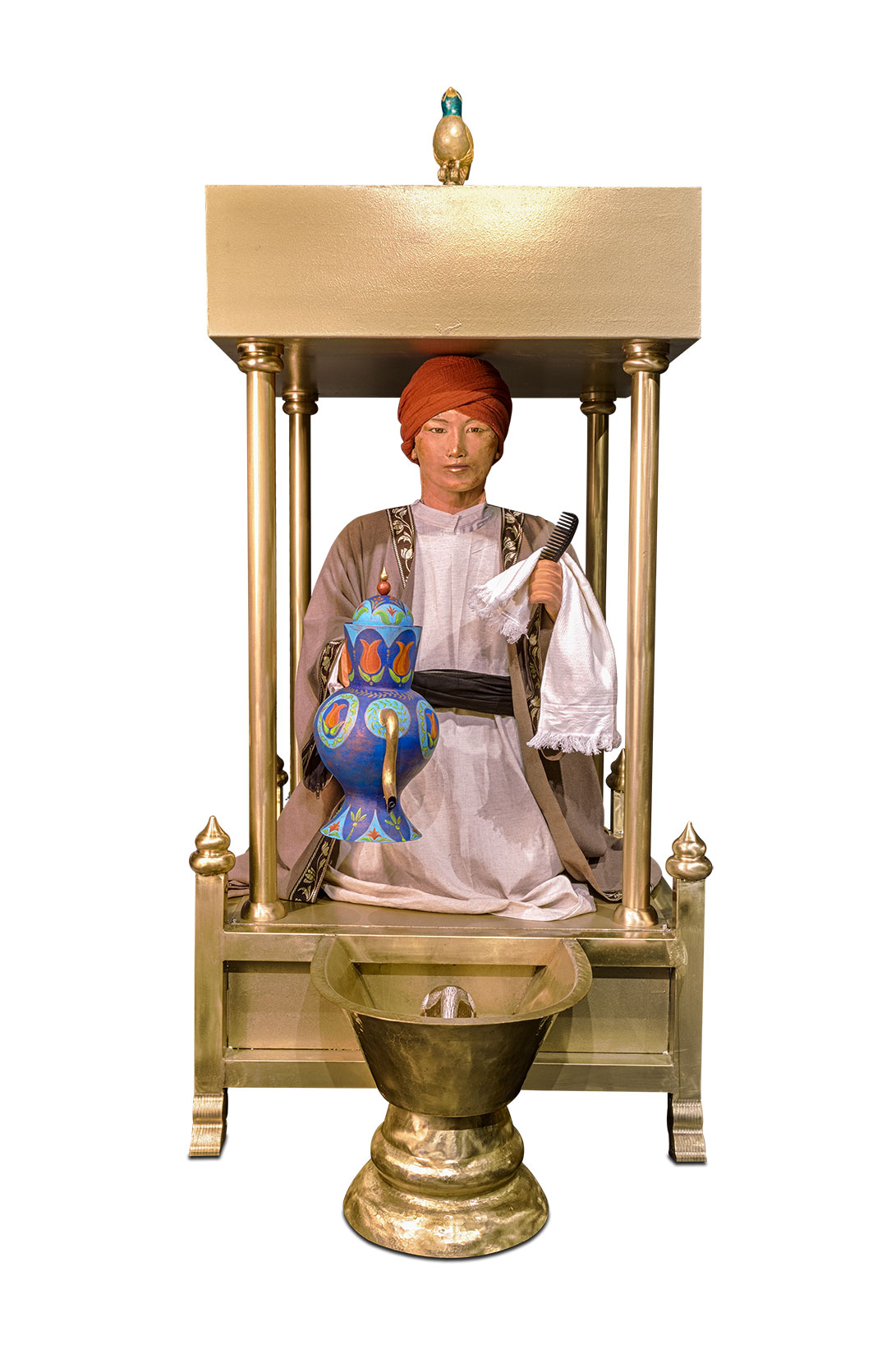
Jazari built an entertaining robot that looks like a bath attendant that is used for washing up. You see a 25 cm tall platform, 4 columns rising for 50 cm from four corners of it, a completely closed tank above them, a dome shaped lid, and a bird perched on the top of it. On the platform, between the columns, there is a boy servant kneeling with a pitcher in his right hand, a towel and a comb in the other, waiting ready to serve. Right before the platform, there is a shallow basin, and a duck inside. As it is seen in many other devices, there is a small handle that is supposed to be turned in the beginning. With this, water begins to flow through a channel that is not visible from outside. As the pitcher is being filled with this water, the air inside gets pressurized, blowing a whistle hidden inside the bird, and giving the impression that the bird is singing. The sound stops when the pitcher is full, and only then the water begins to flow out of the pitcher. Interestingly enough, there is a pause time here enough for washing up. During this time, flowing water fills the basin below. When the washing up is nearly over, water reaches the duck’s neck, and duck seems like drinking it. Right after that, the servant extends the towel with the comb. Jazari used a valve, a pitcher that the air can be pressurized within, a whistle that can be blown by this pressurized air, a flush that reaches from the mouth to the tail, and a float that moves the towel holding arm. Just like his other fountain automata, here Jazari created a device that runs water and performs robotic functions. Just like the Washing Up robot we examine in our Robots section, Jazari aimed for the same functions, and a rich artistic environment for his theatric messages.
How Does It Work?
Bath Servant Boy is an artistic masterpiece with its pitcher and towel holding boy figurine. Through a hole at the head, robot’s chamber is filled with water. Chamber raises a float up. Since the float is up, and the string of the arm is loose at the beginning, arm stays up by the counterweight. Robot is brought to the king for use, and as a stick at its neck is pulled, the conical stopper gets loose, starting to fill the water from the chamber into the jug. As the jug gets filled, the air inside gets pressurized, and blows the whistle loudly. It feels like the bird perched on the jug sings. In the meantime, the king prepares for his bath, and robot looks like waiting for him. When the jug is full to its flushing level, water starts flowing through its nozzle, and the kings washes himself up. Water keeps flowing from the chamber to the jug, lowering the float and tightening the string slowly. As the string gets tighter, it beats the counterweight, extending the arm forward, and when the water is completely gone, the arm stays forwards at a right angle. The king takes the towel to dry himself. The float system that pulls the string here is also seen in other machines by Jazari. The part that Jazari called as “elbow extension” should be made of a heavy material, or a weight piece should be used as shown in the figure. The equilibrium of forces works as follows: the acting weight from the float should be enough to beat the moments in both ways of the joint at the elbow. At the third position, as the hand holds the items, the king completes his washing, and we see the left moment is higher than right after the objects are taken. Thus, the arm goes back up to its original position, making the system ready to be used again.
The Bath Servant Boy Automat Scene Image

This image shows how the Bath Servant Boy Automat designed by Jazari was placed within the court room, and how the sultan used the automat.
Peacock Fountain Automat Reconstructed
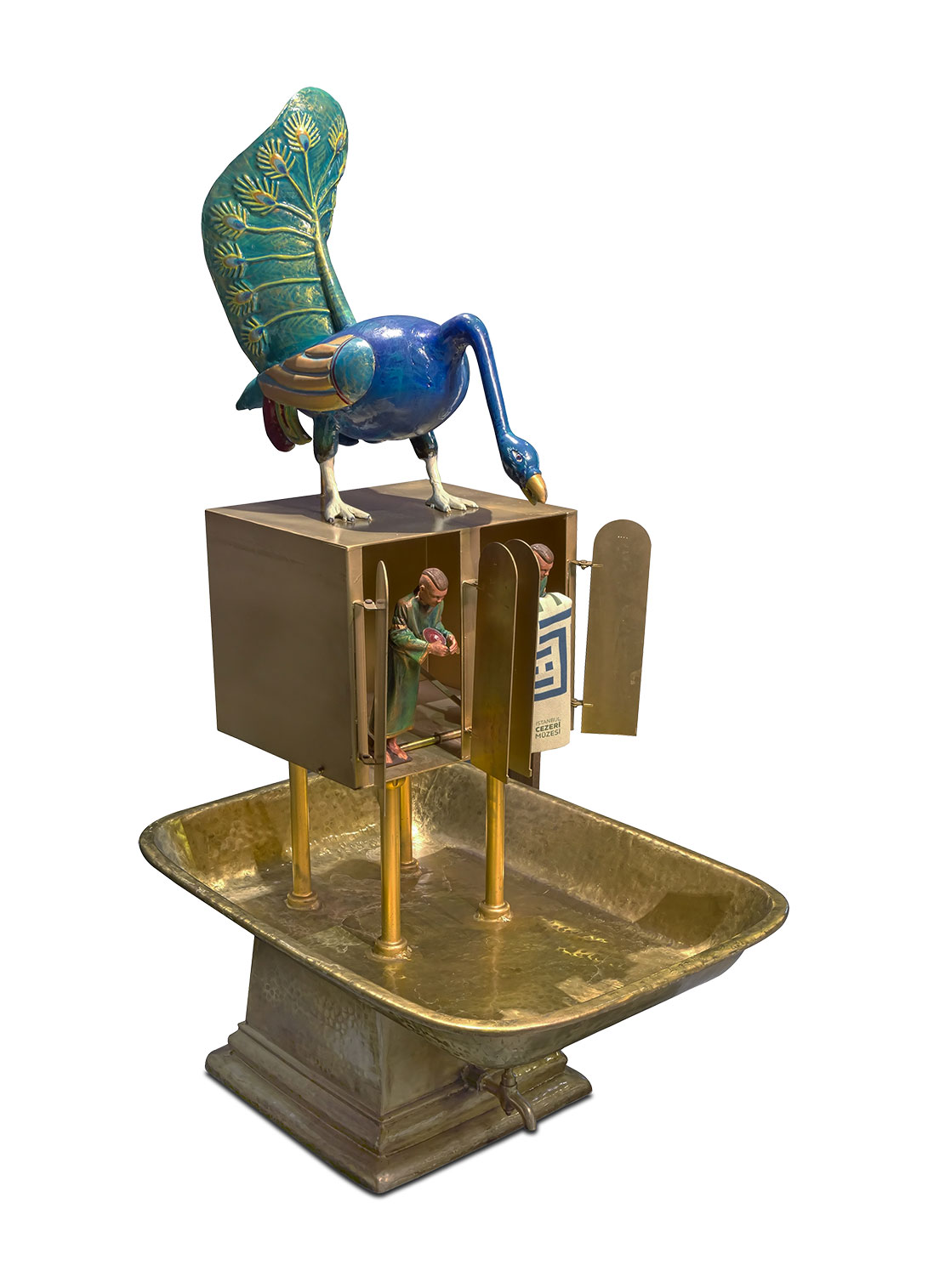
Jazari’s automatic peacock fountain is combined with a pavilion and sink system here, and some robotic features have been added. Peacock is welded on the pavilion, and when the ring on the top is turned, the water begins to flow automatically. In the meantime, as the master prepares, this delay creates the impression of waiting. As the master washes his hands, one of the doors of a closed section Jazari calls as pavilion opens, and a boy figurine comes out, extending a soap box forward. Master continues to his washing, and near the end, just as the water is about to run out, the second door opens and another boy comes out with the towel. After the master dries himself up, the device is taken away from the room, and the wastewater tank below is emptied through a valve. This device is both a highly advanced fountain automat, and also an artistic masterpiece with all its figurines of a peacock and boys. When the flushing level in the lower tank is reached by the water coming from the upper tank, the water begins to be drained. And the actions of the boy figurines are performed by the water filling the lower tank, rising two separate floats in turn. In the end, wastewater if flushed out through a valve in the bottom. It’s amazing to see how Jazari used separated capacity solution to put a time difference between two floats. One of the floats is inside a narrow and high cylinder. A stick over this float pulls a lever connected to the feet of one of the figurines, pushing it out of the door. In the meantime, this cylinder gets filled with wastewater. When the water spills over, the main chamber begins to fill, and the other float inside it triggers the other figurine.
How Does It Work?
The water supplying part of this fountain automat is same with the previous peacock automat. The interior design of the peacock that provides delaying feature also helps to trigger the flush while the sultan prepares. Peacock is inside a pavilion with two doors, which held the two robotic figurines, and this pavilion is installed on a sink with four columns. The next design is about performing various functions by the use of wastewater. Wastewater piled up inside the sink goes into the wastewater tank. There are two separate float systems in this tank. Wastewater fills the first cylindrical tank. The first float here rises with the water level, and triggers the first figurine to move out the door with the soap box. When the first tank is full, the water spills into the main chamber, and as the water level goes up, it raises the second float, which triggers the other towel holding human figurine to move out its own door. When the washing up is done, automat is taken out to be drained of wastewater.
Automatic Peacock Fountain Reconstructed
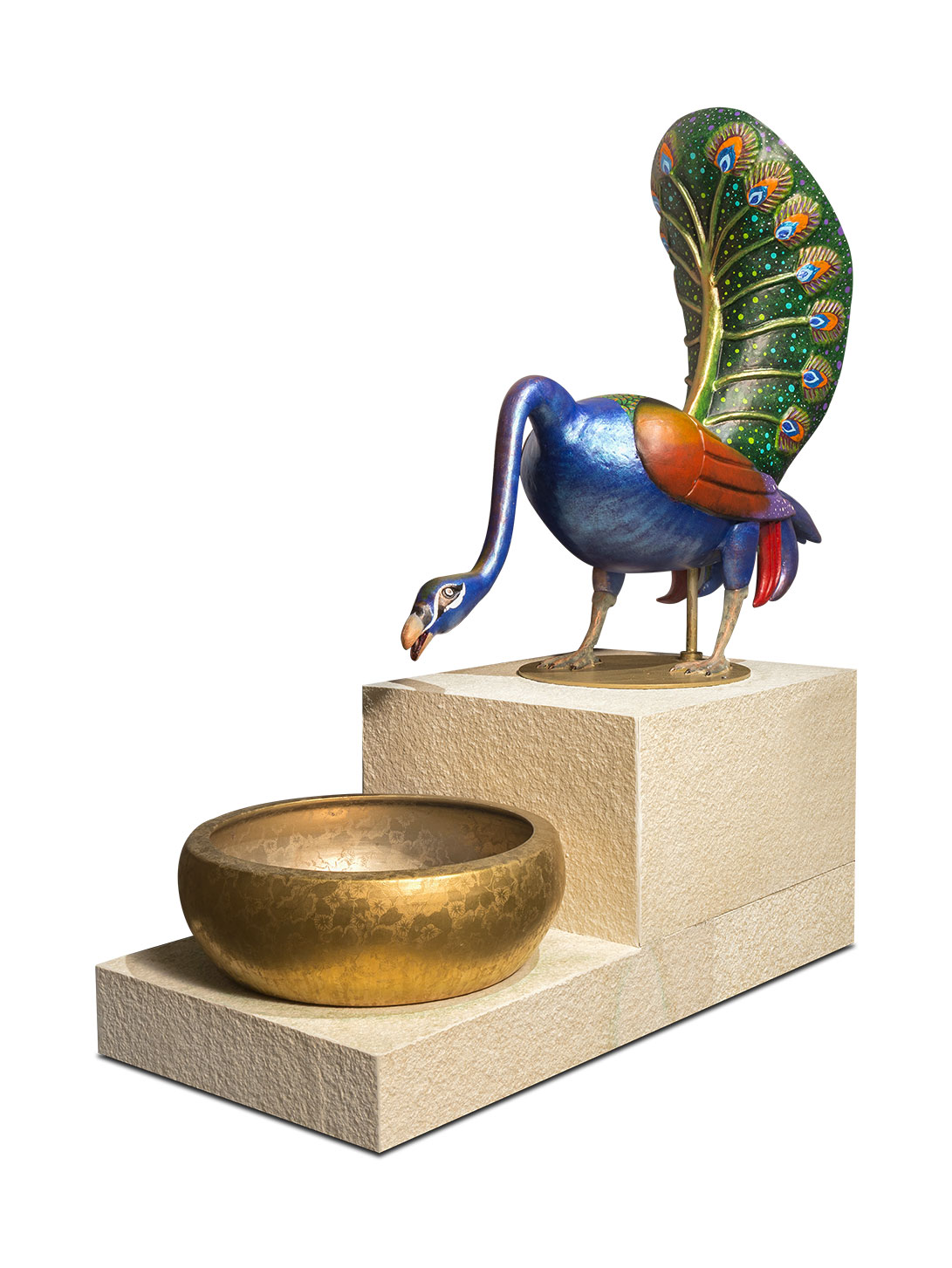
Jazari made another peacock shaped fountain automat for washing up. A peacock is a kind of bird that is very glorious, proud looking, and lovable, but it can’t fly. Since it symbolizes the cleanness in Turkish culture, we see this figure around the fountains a lot. We can consider that peacock automatic fountain was designed to satisfy sultan’s desire to wash himself up without the help of a servant. Indeed, its function is almost entirely same. It runs water after a delaying time. In contrary to scale system in the first pitcher, water flows from the upper tank into the lower one, raising it to the flushing level. The body and tail of the peacock are hollowed. A servant fills these with water in a back room, and brings it to the room where the sultan will do his washing up along with a basin placed under its beak. In the meantime, he turns a crescent shaped handle at the end of its tail. Peacock waits for a short while, and begins to run water through its beak. During this waiting time, master prepares for washing up. After that, peacock is taken out of the room. Jazari tried to create a theatrical scene to give the impression of peacock waiting for its master. In this device, an automatic flushing mechanism used to run water through the beak. This valve can be directed by a stick that extends out of the device. The capacities of these two tanks are nearly same, and in the first one, water is right below the flushing level with a desired delaying time. When the valve is turned on, water beats the flushing level, and combines the capacities together, providing a balance to prevent the device from rolling over both when it’s full and empty.
How Does It Work?
This peacock shaped device is actually an automatic pitcher. The purpose is to run water when it’s on, after a delaying time. Jazari used flushing level principle here again. Peacock has two tanks separated from each other. There is a hole on the plate that separates the tanks, and a stopper valve that controls this hole, which is controlled by a crescent shaped handle. To prepare the automat for using, the stopper is taken out, and the lower tank is filled up almost up to the flushing level. Further this level is from the water, longer the delaying time will be. Then the stopper is placed back, and the upper tank is filled. When the automat is brought in for use, the crescent shaped handle is turned, and valve opens. Thus, water begins to flow from the upper tank into the lower one, and it rises. In the meantime, it gives the impression that the bird is waiting for its master to prepare. When the level rises above the flushing level, it starts running, and water comes out of the bird’s beak.
Peacock Art History Poster

Peacock’s native land is India, and it’s observed in the iconography of many cultures with its gloriously colorful tail. It symbolizes the god of war in Indian mythology, abundance and fertility in Chinese culture, immortality and rebirth in ancient Egypt with its connection to Osiris, wisdom in Sumerians, immortality in ancient Rome due to the durability of its meat, wealth and nobility due to its beauty. In Islamic tradition, during the Umayyad time, its figure was first used among all other animals and plants. In the Abbasid art, we see peacocks that face each other. We can see the same during the Fatimids and Mamluks. Becoming the symbol of heaven in Islamic art, it was used quite often in architecture. In the Safavid architecture, it was used in mosques, tombs, and schools to give some heavenly impression.
Peacock has a special place in Turkish art. It’s mentioned as “Yun-kus” in Divan-u Lugati’t-Turk, and was accepted as a sacred bird that symbolizes dominance. Again, it’s used in Ghaznavid flag for the same meaning. Four peacocks carry the throne of Istemi Yabgu, brother of Bumin Khan, founder of the Kokturks. In 12th and 13th Century Anatolian Seljuk ceramics, peacocks were used in throne room scenes quite often. In Artuqids, second half of the 12th Century, peacock design was used in a double handled copper bowl that was made for Maliq Rukhn al-Dīn Davud. Other than dominance, luck, and wealth, peacock was used as the symbol of purity and cleanness in Seljuk and Artuqid architecture as it is shown with peacock fountains by Jazari.
Peacock Artistic Image
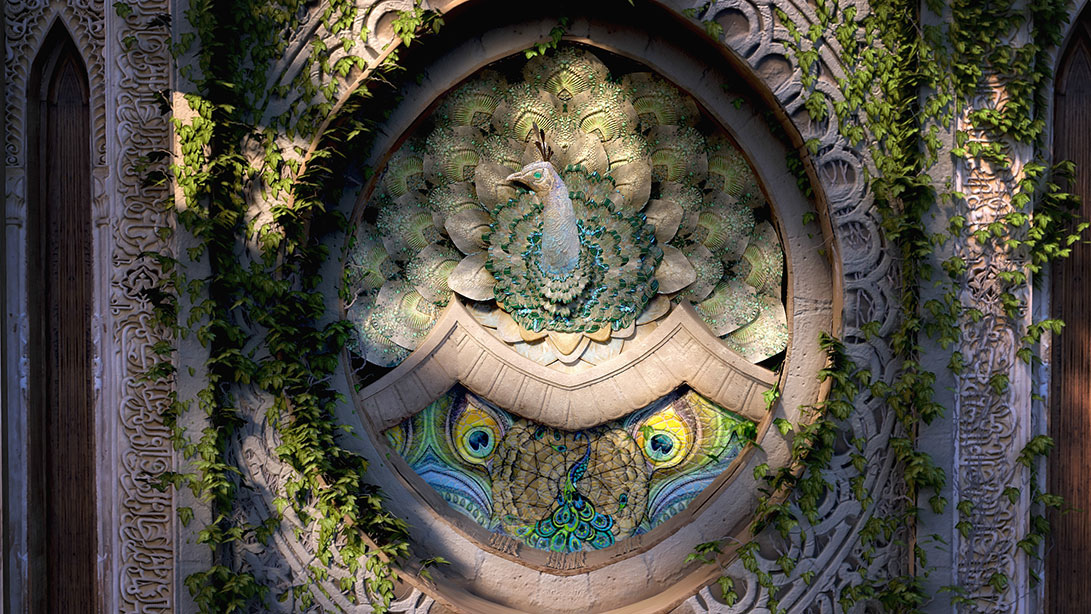
The peacock image seen here represents a style that is seen quite often in Turkish-Islamic architectural traditions. Especially in the sections of courts where is used for water and hygiene, peacock figure is seen very often.
The Drink Serving Boy Interior Mechanism
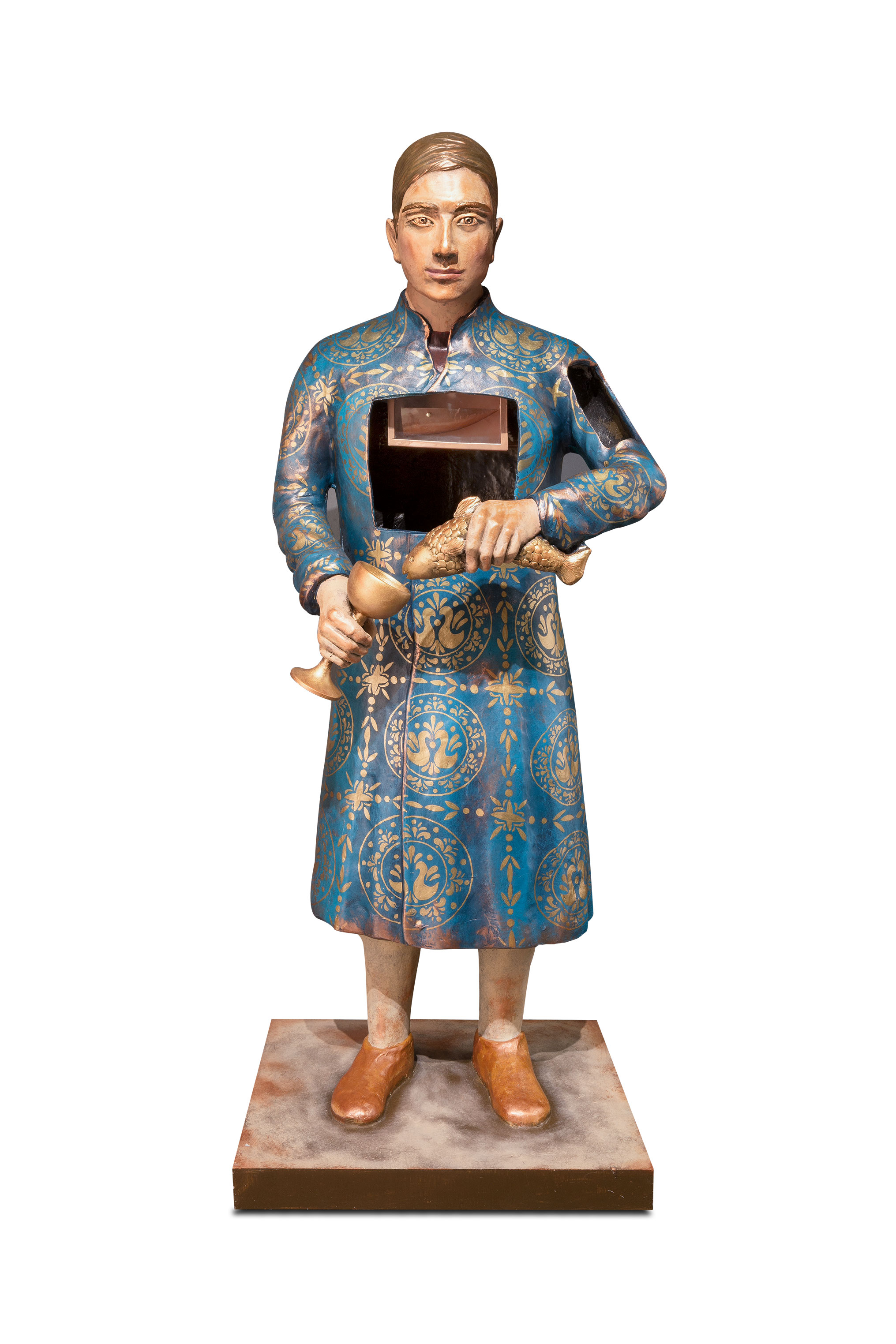
This machine that Jazari describes in the chapter of drink serving automata has a form that looks like a boy serving drinks for the king. Robot pours drink from the mouth of some fish he holds in his left hand into a cup he holds in the other, and when the cup is filled presents it to the guests in the room.
Jazari’s Drink Serving Boy is one of his human shaped machines just like The Bath Servant Boy that comes next. This robot that stands on its own feet takes a place in a social gathering just like any other human being, and serves drinks for the guests just like a human would do. The fact that this robot looks like a young boy shows us Jazari might have had his inspiration from the young servants around the court.
We can describe the robot and its functions as follows: there is a chamber to fill with drink through a hole hidden under its hat, and putting the hat back its place, the robot is ready to serve drinks in a social gathering. After a short while, the fish moves forward to the cup, and when the drink is poured, the fish goes back to its original position. In the meantime, cup holding arm moves a little bit forward to seem like presenting the cup to a guest. When the king or a guest takes the cup from the robot, the arm moves back to its original position. Another empty cup is placed into the hand, and this process repeats with 7.5 minute intervals.
Jazari runs this robot with a device he called “scale.” The scale both collects the drink to pour into the cup, and also works as a timer. The scale that Jazari used in a few water clocks he built is an ingenious timing machine that is based on the center of gravity principle. Based on the timer, it directs the piled liquid into the next element in the system.
The scale that is filled in 7.5 minutes that comes from a chamber inside the chest cavity falls to pour the liquid into the fish, moving it forward, and bringing the cup holding arm down to take it. When the full cup is taken away from the robot, the weight connected to the lever inside the robot moves the arm back up. When an empty cup is placed in the hand, the process repeats.
The Drink Serving Boy Automat Historical Scene Image
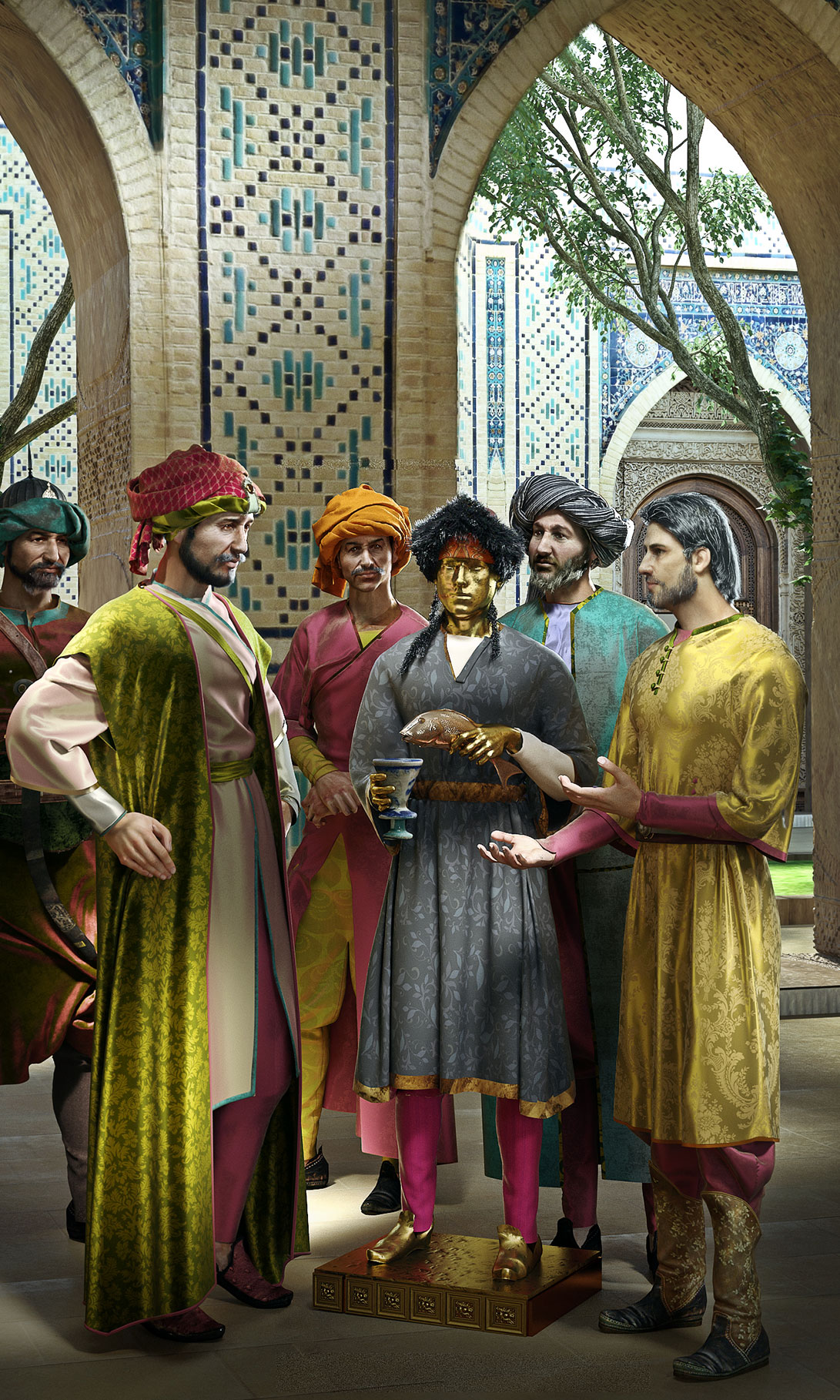
You see how this automat created by Jazari serves to entertain the sultan’s guests in social gatherings. Since it was highly important to keep guests happy both during the political meetings and social gatherings, Jazari must have created these automata that gained Artuqid sultans so much prestige.
Robots in the Past and the Future

Again, an image for the future inspired by Jazari’s automata and humanlike robots. Robots will join us humans in a very near future. When they begin to move among us, we will be talking not only about human relations, but also human-robot relations.
Multipurpose Scale Application
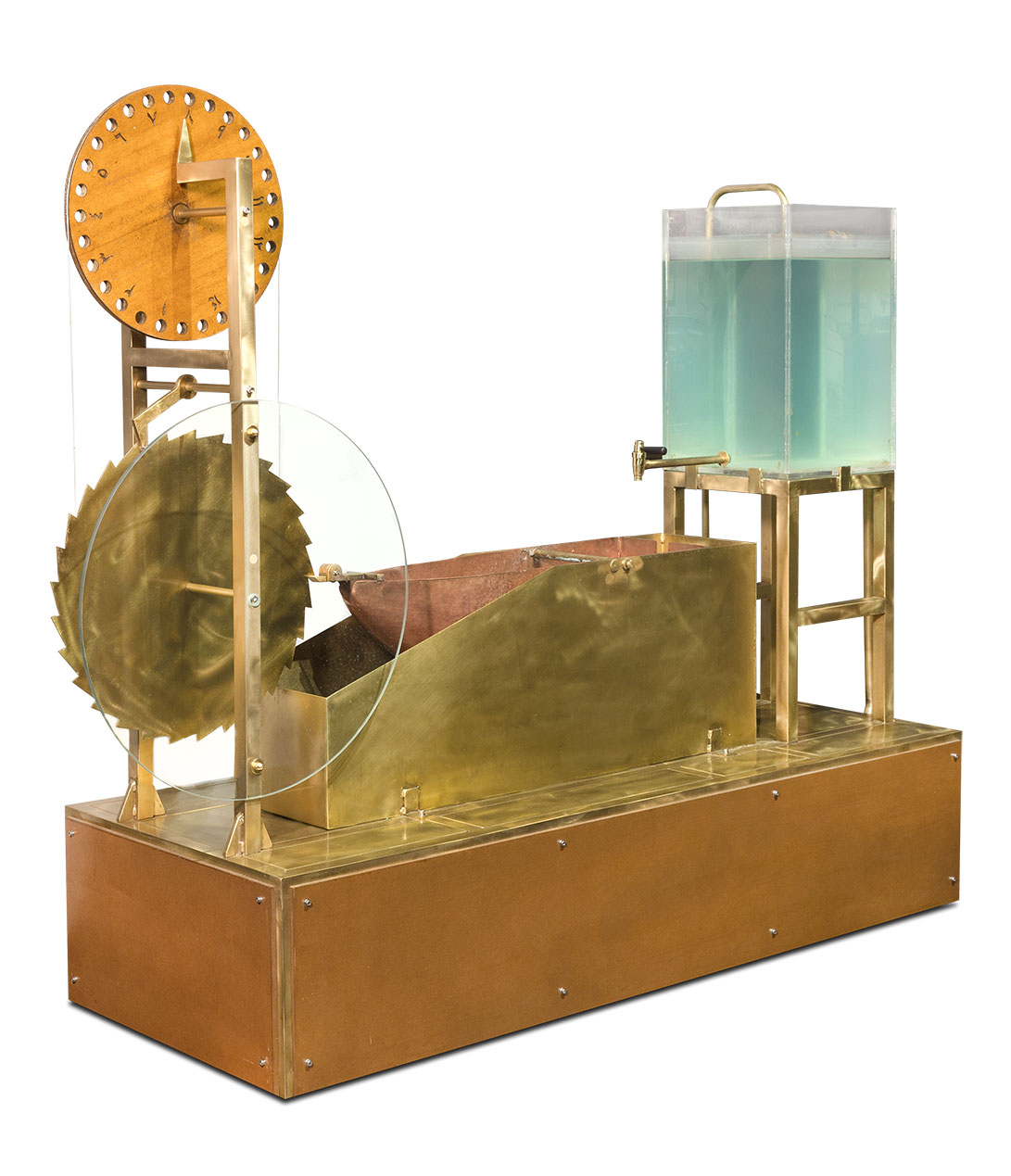
Jazari used the scale mechanism as a timing system or to determine the amount of water to be used. Most important part in this mechanism is how the gear at the end of the scale can turn for only one notch, and use of a system called “escapement” to prevent it from move back.
Escapement is a mechanism in a clock or watch that alternately checks and releases the train by a fixed amount and transmits a periodic impulse from the spring or weight to the balance wheel or pendulum. This periodic impulse moves the arms of a clock forward at a fixed speed. At the same time, the gear gives the timing element a pushing force, and another gear locks into it, fixing the gear.
For Peacock Clock, in addition to hinged clamp, another fixed clamp was used as a one-way locking mechanism. When these two hinged clamps are combined together in a structure, it’s same with the escapement clamp that’s used in mechanic clocks of modern times. The scale looks like a half boat, meaning the front part is wider to the upper sides.
Ox Drink Automat Holographic Scene
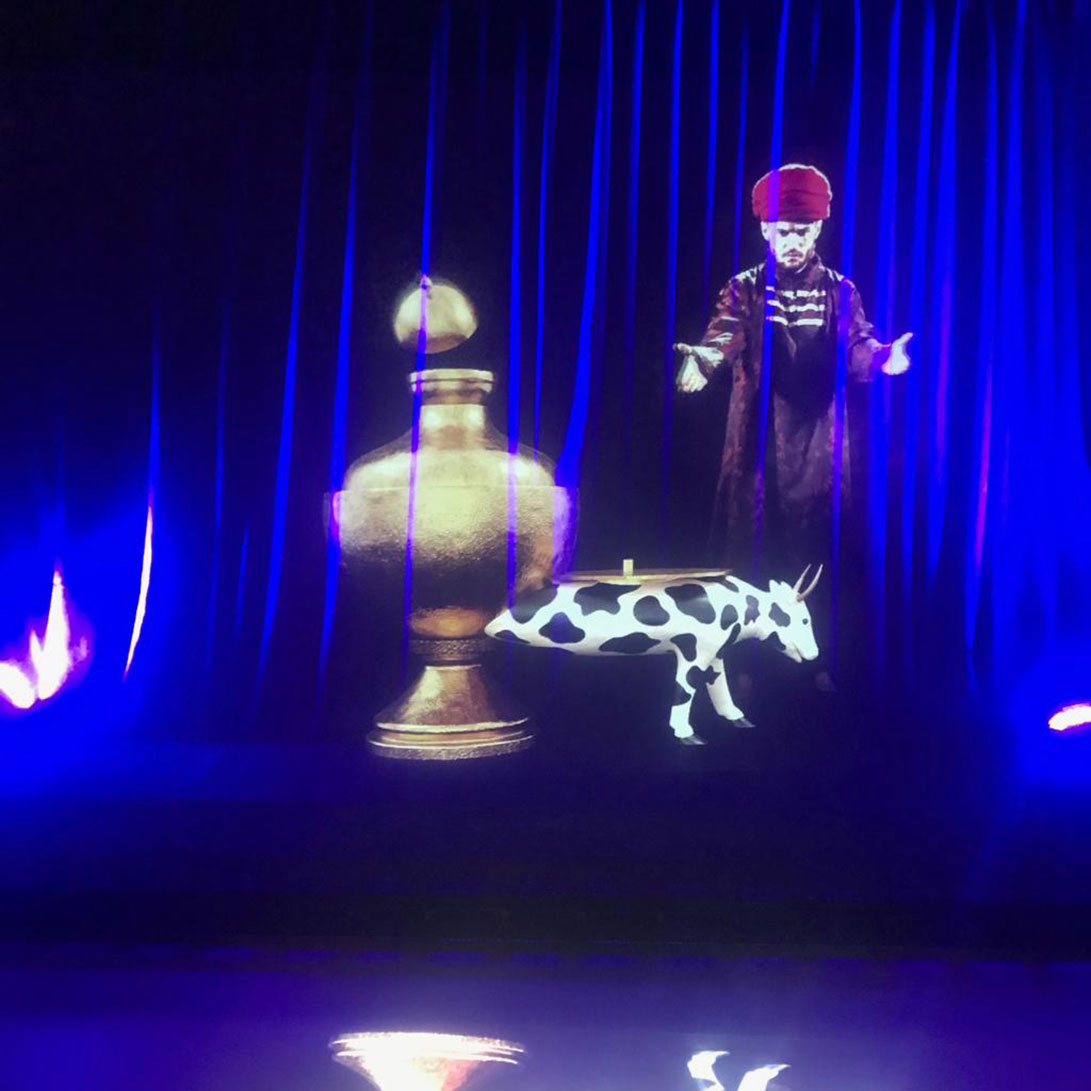
Jazari mentions about Ox Drink Automat in his book, emphasizing how he fills 4 different drinks with different colors through the same hole without mixing them with each other and water inside, presenting it to the guests as a magician trick. Creating a scene, we wanted to show you how this magical looking feat is done. Each drink is filled in a way to fill each department. When the first liquid is filled, it raises the float, and the chamber’s hole is closed so that the other drink can be filled into the next chamber.
Ox Drink Automat Reconstructed

The last one of Jazari’s drink automata for entertainment purposes is a machine called Ox Drink Automat, which comes with an illusion trick. This device helps the user to entertain their guests with a special trick. On the other hand, the aesthetic design and the figurines also tell their own story. Indeed, when you look at it, you see a vendor riding on his ox with a drink jug. From this scenery, we can understand that, during the Artuqids time, vendors sold drinks carried in jugs over their oxen in the streets. The host or a servant fills this device with drinks in front of the guests. However, these four different drinks with different colors, and water. Opening the lid, all of them are poured into the jug through the same hole in turn. Observers think all these drinks will mix inside the same jug. However, when the vendor figurine is moved to the desired position on the mixing dial to let us get our choice of drink, it becomes a surprise. Again, with the help of the dial, these drinks can be mixed as desired. In another word, while these drinks don’t get mixed inside the jug, they can be taken out plain or mixed as desired. There is a very special mechanism at the neck of the jug to prevent the mixing. With the help of this mechanism, drinks go their designed chambers. To get the drink as we want, we move the hand of vendor to the symbol on the dial that shows our choice. A valve inside the ox, which can be as an early example of what we call as multiport hydraulic valve, opens the channel we want from the jug to our cup. When the cup is full, we move the vendor’s hand to the nearest closed symbol to lock the valve. It’s known that this amazing mechanism and multiport valve were developed by Jazari. The device is 68 cm high, and 75 cm tall.
How Does It Work?
When the lid is open, it shows like there is a direct opening into the jug, but actually there is a conical middle lid, helping the poured drink move into the designated department. In this section, there is a designated pipe that leads to a different chamber. The heights of the pipes are adjusted based on a special filling plan, and it makes sure the drinks go to their designated chambers without mixing. When each chamber is full, a spherical stopper closes the hole. There is a hole at the bottom of each chamber, and drinks are directed to the multiport valve through these holes. This valve has a very complicated design that makes the desired combinations, and it’s turned by the vendor figurine sitting on its dial. According to the ways opened and closed by this turning, drinks go to the mixing channel at desired amounts, and the mix come out of the ox’s mouth through a pipe.
Ox Drink Automat Transparent Mechanism
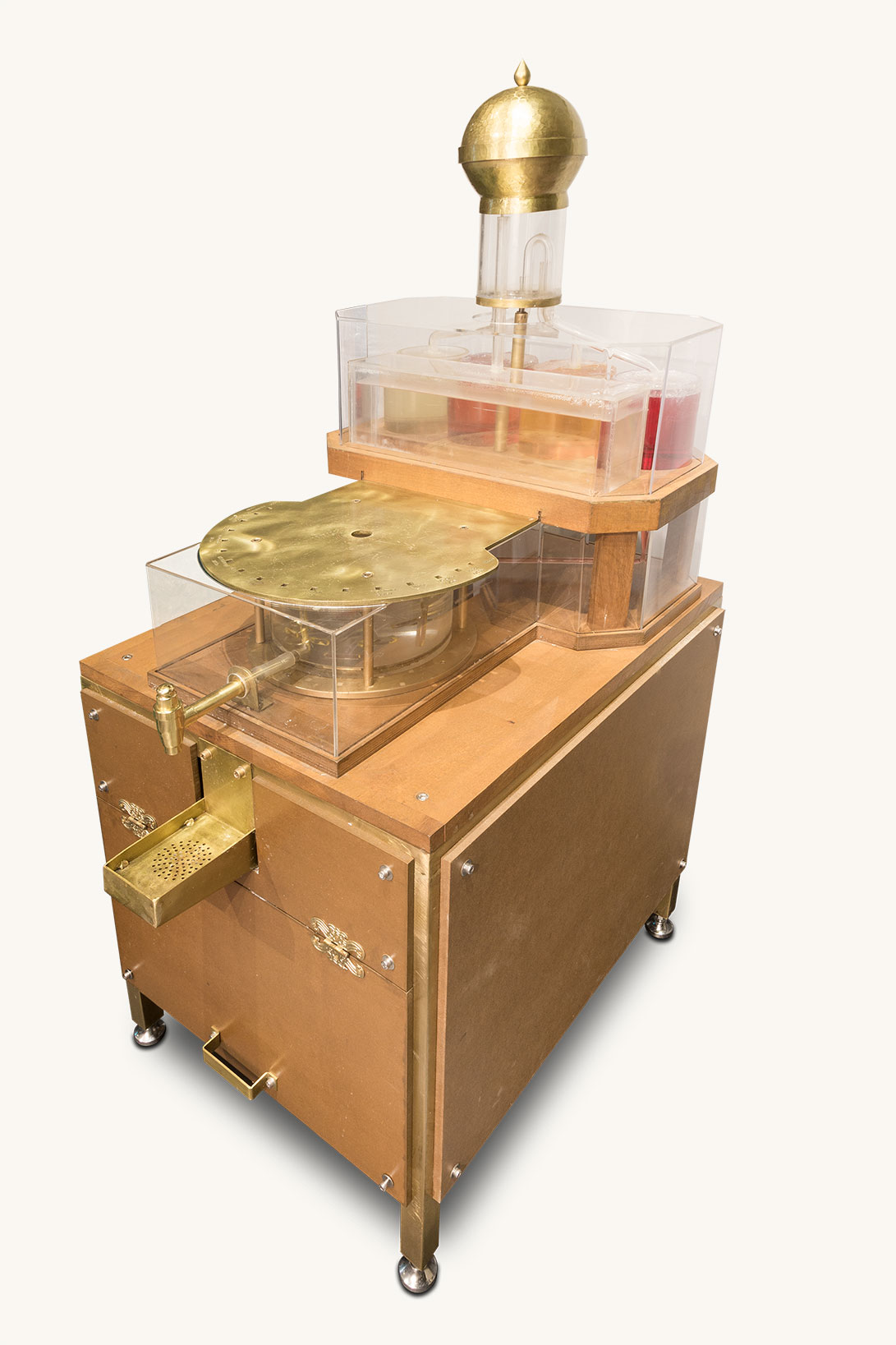
This mechanism was made to show the illusion that transpires inside the ox automat. Special flushing and stopping systems were used to prevent different drinks from mixing, and pipes at different heights used along with a flush for the water. Since the water level remains below other pipes when the first drink begins to fill, it doesn’t go into the other chambers. When this chamber is full, the stopper closes, and other liquid doesn’t go in to the first one. When the next drink is in turn, it moves through the shortest pipe to fill the second chamber. When all the drinks are poured in turn, water is poured as last.
Through the pipes under these chambers, it’s transferred to the complicated valve in front. This valve has ways that don’t intersect others, and each of them meets a drink that comes from a different pipe. When the choice is made on the dial, the valve collects the required drinks, and mixes in frontal channel to send to the faucet.
Multiport Valve

The platform upon which the ox driver sits is a mixing dial. The amazing valve inside the ox mixes the drinks as desired from the dial. As it can mix the drinks as desired, it can provide the drinks as plain, too.
Blood Measuring Automat
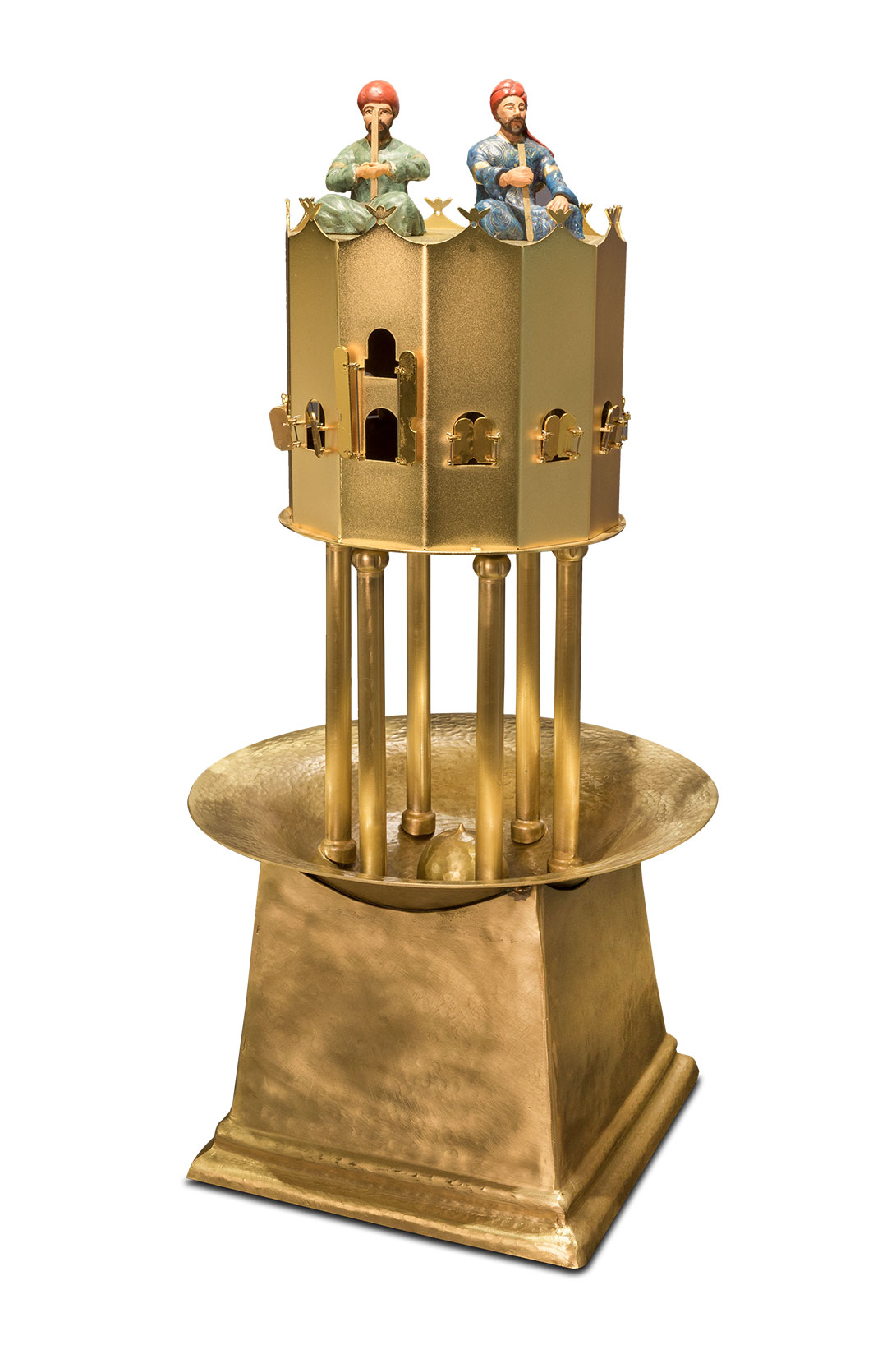
This blood measuring automat is a device is another version of the two clerk device with a closed prism-shaped box with 12 doors and 12 corners, which he calls as manor. The columns are more in number for they need to look like carrying a heavy load. And since the device looks like a glorious manor, it’s called as “blood measuring vessel with a manor.” As blood pours into the vessel, it goes into the base, and in the meantime, the clerk with the pen rotates on the dial it sits, and other clerk shows the amount of blood with a ruler raising between its hands. At the same time, at every 10 dirham (around 32 g) blood taken, another door opens in turn, and a kid figurine shows up. The kid at the first door shows the number 10. As the other doors open, it goes 20, 30, and multiples of 10. Special symbols are used with finger positions. Also, through a window over the first door, a hand shows up to show the amount of blood at 10 dirham sections. We don’t exactly know the numbers shown with human figurines and finger positions. However, based on the information given by Jazari, we know that there are 12 different signs as multiples of 10, and probably more. Jazari emphasizes that the person who gives blood should see the amount for the entire time. Therefore, combining all the techniques he used in his previous blood measuring devices with much more advanced mechanisms, he makes sure there’s a dial showing the amount regardless what angle it’s looked at. Jazari used the same mechanism, which he used in this device to open the door, with the ones he used for Astronomical Clock and Door Candle Clock. As the blood raises the float, just like it is in his previous devices, the ruler goes up, and the pulley system rotates the clerk.
Classic Medical History Poster

Science that Tampers the Clock Called Human Body: Medicine
Science and technology has such a part in our lives so great that, especially MRI machines, surgery robots, or drugs specifically produced for different diseases, make us feel that there is an insurmountable rift between us and those people who lived just a hundred years ago. However, at a closer look, it shows that even the medical knowledge from a millennium ago had the traces of what we know today. Even if it wasn’t possible to observe how the human body works when alive, or we didn’t know about the microbes yet, preventing us to get to know more about the human anatomy, it didn’t stop the medical techniques from making an mind-blowing leap.
Abū al-Qāsim Zahrāwī, who lived in Andalusia in 10th Century, noticing the uselessness of traditional tools, invented around two hundred tools and devices designed for various purposes. From the scalpels to cut tissue samples or tumors to tooth cleaning apparatus, cautery tools, surgery scissors and all, which some of them are still in use even today almost with no change. Zahrāwī wasn’t the only medical genius in Islam culture. In the same century, Ali ibn Isa’s mention of 130 different eye treatment techniques, The Canon of Medicine of Avicenna that has been the main reference book for all the medical experts both in Eastern and Western worlds for around a millennium, highly detailed eye treatment ways of Andalusian Ghāfiqī who lived in 13th Century are just a few samples to show how advanced the medical knowledge was in Islam culture.
It was only possible by vast experiences of long years for the doctors reach this level of knowledge, and the main source of this experience was the hospitals. One of the most important examples for the hospitals we see almost everywhere in Islam culture is Nīr al-Dīn Bimaristan that was built in the time of Artuqid Sultan Nūr al-Dīn Muhammad, in 12th Century. This bimaristan that served patients for free, because it was a foundation, also was a medical learning center.
Classic Medical History Image
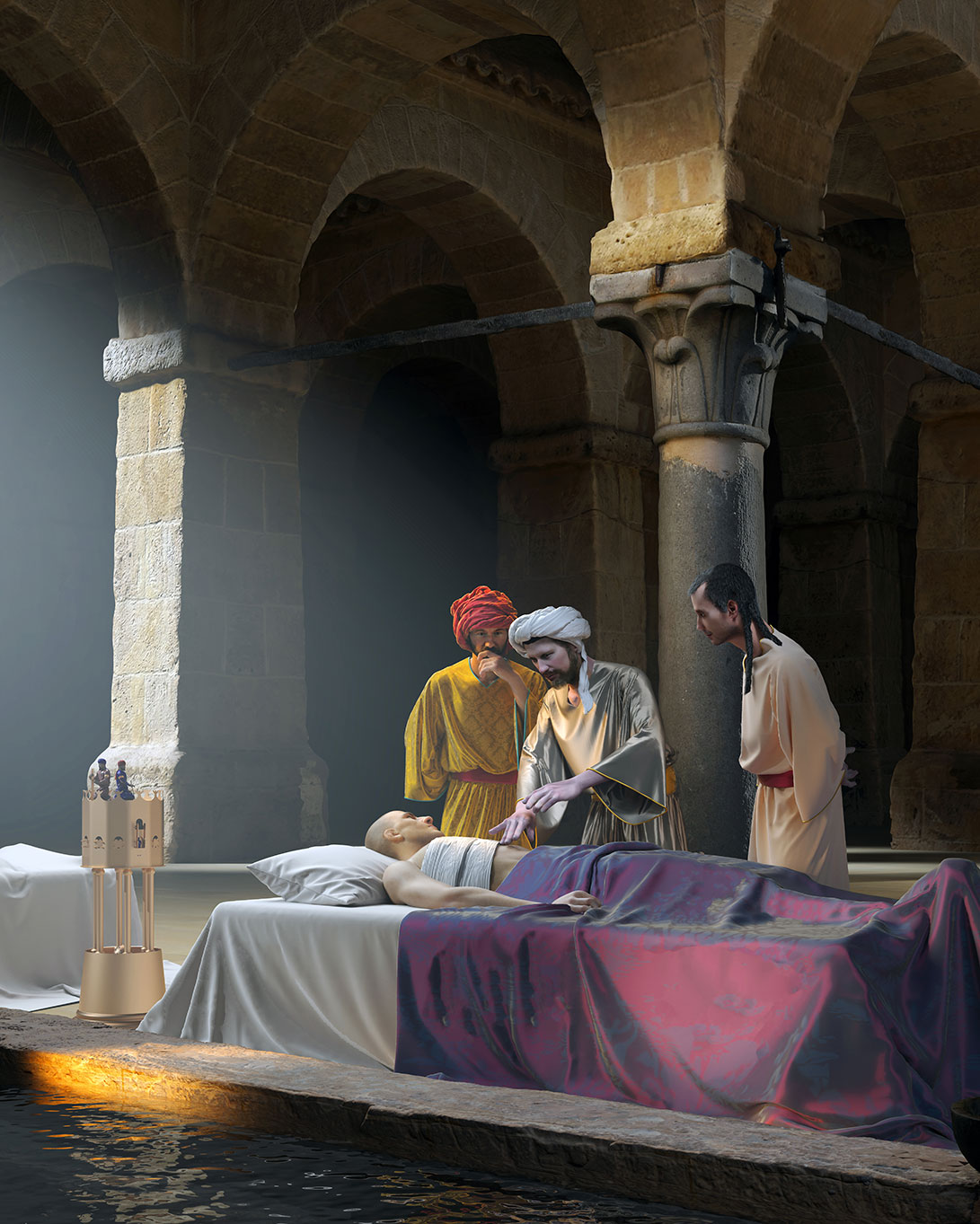
In this scene, we see how Jazari’s blood measuring automat was used to take blood from a patient by a doctor. While it’s not a method advised by the doctors today, it was a very common application in medicine to heal the patients just taking blood from them.
Hooter Automat
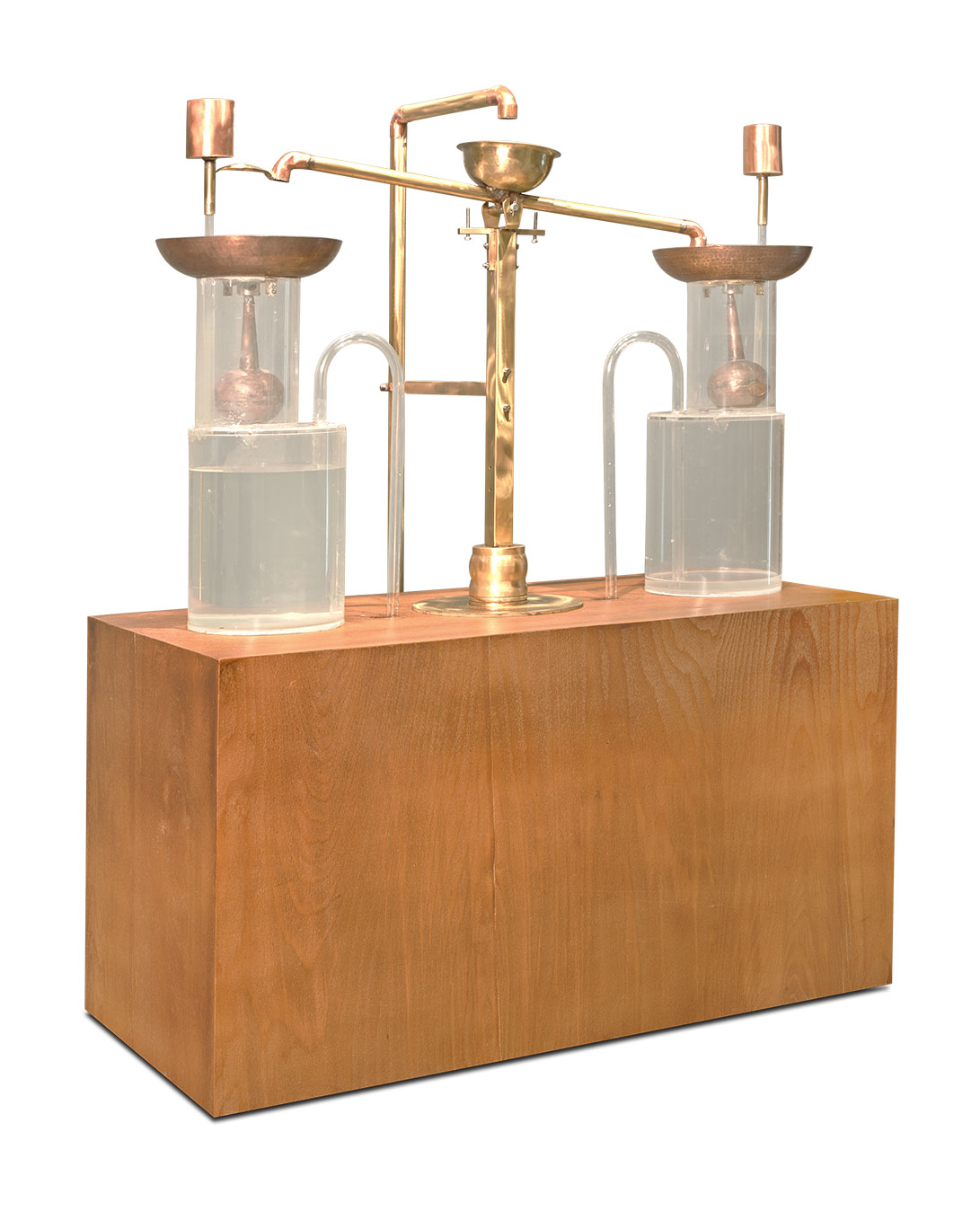
With this device he called as zemr, Jazari shows he can create lots of different mechanisms. In this device, again, there are two separate pressurized air cups with flushing systems. While the pressurized air cups are filled, the horn blows and each cup is drained by its own flush when full. It’s important these flushes to have crook points are at the same level with the upmost surface level of the water.
Musical Boat Automat Diorama
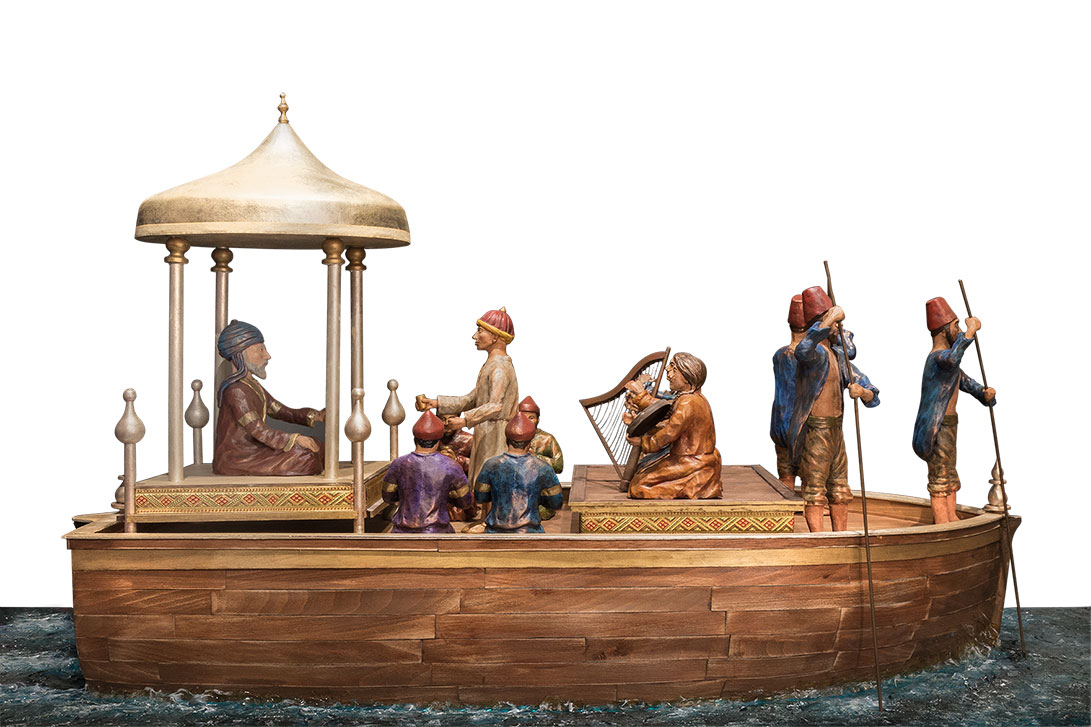
In his book, Jazari explained his musical entertainment boat in the section where he wrote about his devices that were made for entertainment purposes. Actually this device is not a clock, and there are no dials or signs on it that shows the passing of time. However, this boat that is placed in a pool during a social gathering is a musical boat that makes fun sounds at the turn of every half an hour. Therefore, we can think it as a clock that sounds alarm at every half an hour. Jazari used many of the mechanisms he used in his other machines for this 175 cm long boat. With a theatric approach, he created a scene of the river trips sultan had with his guests. While the moving figurines in this system are just percussionists, it’s one of the most crowded and glorious device made by Jazari, with its colorful human figurines.
The exterior design of the boat is very interesting. The sultan sitting at the stern of the boat, a servant with a pitcher and cup in hand right before him, a guard on each side, a page, and guests sitting here and there. Right across the sultan, on a little higher platform – this is also a closed water tank – there are musicians who play mizmar – some sort of a pipe – tambourine, and harp. At the bow, we see a helmsman, and an oarsman on each side. The mechanisms are installed inside the body.
Classic Musical History Poster

Rhythm of the Universe: Music
It’s almost impossible to imagine human beings without music, and the musical instruments from thousands of years ago are the proof for that. From Mesopotamians to Africans, Chinese, and Native Americans, almost every civilization has musical traditions with a past of thousands of years. Music was transferred from one generation to the next. Eventually, systematic musical theories were developed, and it was deemed as important due to its harmonic value to such an extent that in ancient Greek and Islam philosophies, music was deemed as one of the four pillars of mathematics with arithmetic, geometry, and astronomy. Indian civilization used music as the language of the mystical world. This approach was embraced, first, by the Greek thinkers, and then Islamic Sufis. Greek philosopher Plato emphasized that music has a very powerful effect on people, so the musicians had moral responsibilities. And again, some Greek scientists worked on musical therapies.
The theoretical development of music continued in Islam civilizations beginning in 9th Century. First Islamic philosopher al-Kindī, al-Farabī in 10th Century, and Avicenna in 11th Century suggested more sensitive tuning systems that improved the gamut of ancient Greek, designed various musical instruments, and examining the connection between music and soul, they tried musical therapy techniques. In Islam culture, music was apparent everywhere. From Baghdad to Granada, it was an essential element of court life. Again, Turks carried their musical culture from Middle Asia to Anatolia through Yasawids, Bektashism, Alaouite, and Mawlawiyah. Especially in Anatolia, they were highly influenced by the musical approach of Byzantine and Islam civilizations, bringing them into new disciplines. Music was also highly important for Jazari’s automata and other machines. Especially in his Musical Entertainment Boat, and Astronomical Clock, we can see the peerless use of music combined with mechanics.
In the Western world, music was developed mostly in the church circles during the Middle Age, and it kept its “divine” aspect during Renaissance. After 1600’s, Western music passed through Baroque, Classic, and Romantic phases. In this period, many musical genius like Bach, Vivaldi, Mozart and Tchaikovsky created works that leave us in awe even today. Thanks to the globalization, music continues to improve with new forms influenced by many cultures.

